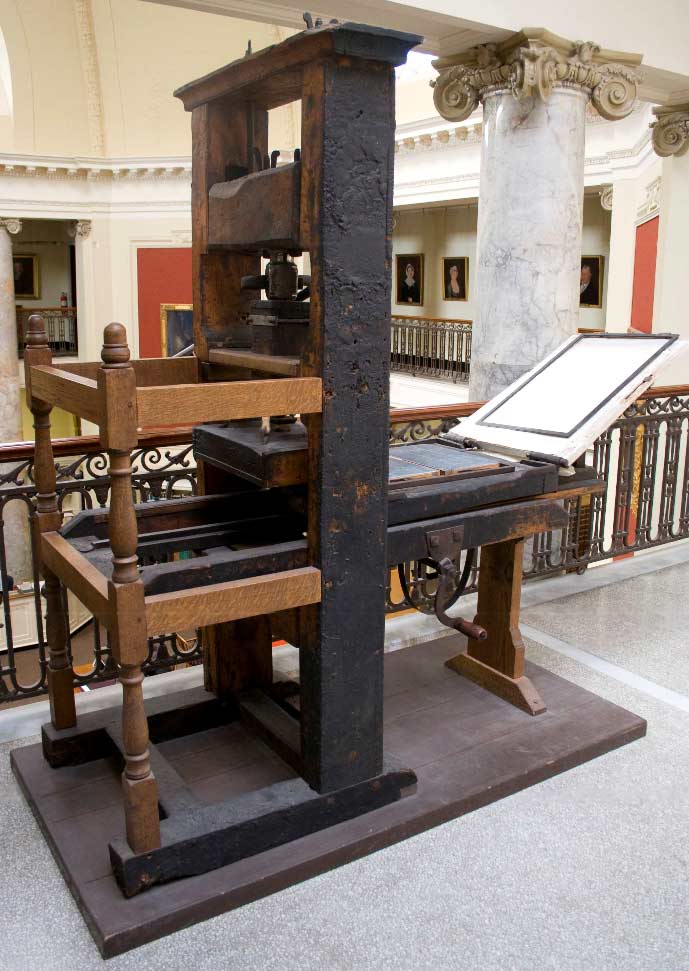Last month, I became the new lead of the Ooligan Press digital department, and I’m thrilled because I’m a huge fan of the work we do in digital. I’m proud of the websites we oversee: Ooligan Press, our Publishing program, and the new and evolving Oregon Authors site. But my real passion is ebooks. I love reading them, I love making them, and I love the potential that they offer us as publishers and as readers. At the same time, I recognize that digital can be off-putting for those who are passionate about printed books, and so I’d like to reveal how I fell in love with digital publishing.
The romance unfolds in an unlikely spot: the rotunda reading room of the American Antiquarian Society, where I first made the acquaintance of a 240-year-old printing press named “Old No. 1.”
For those who aren’t familiar with it, the American Antiquarian Society is a treasure of an institution in Worcester, Massachusetts; a learned society and research library, the AAS has preserved over three million books, pamphlets, newspapers, periodicals, and other printed material created in what is now the United States, dating from the first European settlement to 1876. The AAS was founded in 1812 by a man named Isaiah Thomas. (If you’re a basketball fan, no, not that Isaiah Thomas; and if you’re an old basketball fan, no, not that Isiah Thomas either.)
This Isaiah Thomas was a Revolutionary War printer who published a newspaper called The Massachusetts Spy. It strongly supported the cause of American independence—so much so that the British authorities referred to Thomas’s printing office as “the sedition factory.” Thomas heard that the British were planning to shut him down, and knowing how important it was to keep the flow of information going, he moved his press from Boston to Worcester to keep it safe on April 16, 1775 in the dead of night. Many years later, Thomas donated that press to the American Antiquarian Society. “Old No. 1,” as Thomas described it in the donation documents, now resides on a balcony above the reading room of the AAS.
In 2014, I spent a month at the AAS doing research for a nineteenth-century detective adventure called A Person Known to Me. The project is an experiment in mixing different forms of storytelling in a single integrated narrative whole, and I realized that to combine the many types of of media that were part of the project, I would need some programming skill. Using resources suggested by Derek Sivers, including the book Head First HTML and CSS, I began to teach myself programming. By day, I was a researcher in the library, paging through nineteenth-century dime novels, newspapers, and other gorgeous resources unearthed for me by the AAS librarians; by night, I was a fledgling student of computer programming.
One day, as I sat working in the library, I looked up at Old No. 1 in its balcony perch and thought about how much precious information regarding the American Revolution it had conveyed. In that instant, I was struck by the power of what I had been learning during those evenings spent poring over my programming books. Anyone who was willing to spend some time, like me, could now build a virtual printing press. Any of us could follow in Thomas’s footsteps and take on his mantle of publishing responsibility and civil action.

My path after that moment delivered me to Portland State University, where my focus has been on digital technology and what it can do for publishing. (I define “publishing” in the broadest possible sense, incorporating as many forms of media as are necessary to tell a story well. To see some wonderful examples of journalistic use of this kind of storytelling, check out “Snowfall” from The New York Times and “Hell and High Water” from ProPublica.)
What possibilities exist down this road for even longer-form narratives? What would Isaiah Thomas have been able to do with all of this, if he too had known HTML and CSS? And how can we in the digital department and at Ooligan Press honor and advance that heritage?

